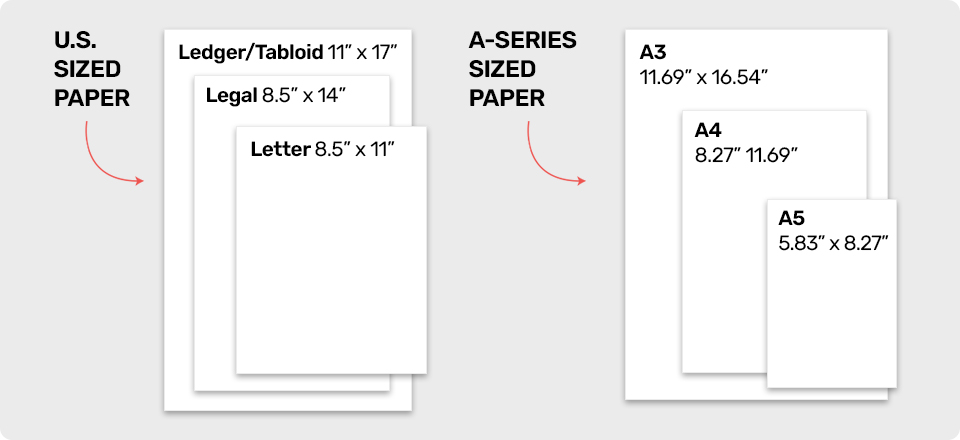alt-text
It blows our hivemind that the United States doesn’t use the ISO 216 paper size standard (A4, A5 and the gang).
Like, we consider ourselves worldly people and are aware of America’s little idiosyncrasies like mass incarceration, the widespread availability of assault weapons and not being able to transfer money via your banking app, but come on - look how absolutely great it is to be European:
The American mind cannot comprehend this diagram
[Diagram of paper sizes as listed below]
ISO 216 A series papers formats
AO
A1
A3
A5
A7
A6
Et.
A4
Instead, Americans prostrate themselves to bizarrely-named paper types of seemingly random size: Letter, Legal, Tabloid (Ledger) and all other types of sordid nonsense. We’re not even going to include a picture because this is a family-friendly finance blog.
Aside from the 1 to √2 ratio, the area of A0 paper is exactly 1m². People behind ISO 216 thought of everyting.
From their website: “We’re ISO, the International Organization for Standardization. We develop and publish International Standards.”
Sadly, ISO in recent decade started to do bullshit. They don’t pay for standard development, they don’t employ anyone for standard development, they collect membership fees from national standards organizations, require payment to download most standards and don’t allow to copy published standards. Also they retroactively paywalled a lot of standards.
People behind ISO 216 thought of everyting
how to make a good standard:
step 1: copy from DIN
Well, Germans are pretty anal about standards (thankfully) and they do them right, so why not copy them?
so why not copy them?
oh, I totally agree with you.
In fact standards are made to be copied. That’s like the entire point of them.
The world would be a better place if we copied good things more often.
Imagine all of Europe copied Dutch transportation-, German prostitution- and Portugese drug-policies
Which is awesome, because every number up halves the size. This, combined with the standard way that paper weights are given (e g. 80g/m2) allows you to easily calculate how much a piece of paper weights: 1 A4 80g/m2 weighs 5g (1/2^4 * 80g)
Now it makes even more sense!
Do Euro printers say PC LOAD A4?
I think they probably do.
I want to only briefly defend the NA system in terms of naming. I get it, I worked in printing for decades, I know how shitty it all can be. But Letter and Tabloid communicate well for something that is otherwise all the fault of press guys.
You really think people are too dumb to remember 2 letter codes that are literally printed on everything? Come on man :D
yes, thats why i always was confused when i heared people online talk about pc load letter.
i kinda assumed it was just an odd way to refer to paper that some manufacturers used
Well, it’s 2024, so they mostly say things like “out of A4 paper - load A4 paper in tray number 3”. But yeah, they used to.
Interesting, no photos of that message come up.
TBF, I only remember messages about “out of paper” or “all trays are empty”. Why specify paper size if the printer accepts different ones, anyway?
I’m thinking it lets a tray run out, then you ask it to print on a certain size of paper, and in response it asks for more of that size paper. Then you know which exactly it’s out of. Good for an office too where you don’t know who printed what.
Well, one still could do it like how many countries transitioned to the metric system: slap the traditional names onto things that are actually now defined by the metric system, like how China’s catty, about 0.60478… kg, became 0.5kg. Just slap “Letter” onto A4.
That’s going to make some driver developers very upset. And sensors in printer cartridges that can sense both A4 and Letter.
I say we just balls the whole thing. Screen or pencils.
For technical purposes that need to handle both you can just disambiguate it with “Letter (new)” and “Letter (work or school)”
Is that a subtle dig at Microsoft and their 5 billion different versions of Teams?
1.414, the magic number.
Is this why my printer has wierd size “letter”, that is not sized like letter?
Yeah, US software always defaults to their own non-compliant standards instead of looking at the location and determining the default that way.
That is why we in Europe and all the other parts of the world get these strange fuzzy prints where the text is almost unreadable, and is cut off on strange parts in the text.
This sounds like our bad, sorry.
To be fair, A4 yields unwieldy pages that are too long to comfortably read. And when do you ever need the feature to fold an A4 sheet into A5?
Are you american? If so, the “unwieldy and too long” is probably because you’re not used to it. I’m not used to letter-size and it seems weirdly short and unnecessarily wide but I know it’s because I’m just not used to it.
I’m German. If the pages are a comfortable size, why does no publisher ever use A5 or A4 paper? To quote an answer I gave to another comment here:
Let’s check. I grabbed four random German books from my bookshelf. If you’re right, the pages should either be roughly 30cm×21cm (A4) or
15cm×10.5cm[Edit: 21cm × 15cm] (A5).Book 1: 18cm × 11.5; book 2: 19cm×12.5cm; book 3: 20.5cm × 12.5cm; book 4: 24cm × 17cm. None of those conform to the standard.
Another hint that the paper format is weird is that scientific papers on A4 are always either printed in two columns or use the ninths rule for margins, i.e. 1/9 of margin on the inner and upper edges and 2/9 of margin on the outer and bottom edges, essentially throwing away almost half of the page (I’ll admit there are more economic recommendations of 1/11 or 1/13). This is to make the columns narrower to get closer to the target of 60–80 characters per line. Note also that this makes the ‘usable’ area approximately 20cm long, which is much closer to the American’s ‘Legal’ format (216mm).
Let’s check. I grabbed four random German books from my bookshelf. If you’re right, the pages should either be roughly 30cm×21cm (A4) or 15cm×10.5cm (A5).
Book 1: 18cm × 11.5; book 2: 19cm×12.5cm; book 3: 20.5cm × 12.5cm; book 4: 24cm × 17cm. None of those conform to the standard.
A5 is not 15x10,5
If A4 is 291x210 then OBVIOUSLY the next one starts with 210: 210x148.
You’re right. Sorry for getting my post-7pm arithmetic skills on you. However, my point still stands. ‘Close’ is not ‘conforming’ to the standard.
Close to your non standard book measurements. I really appreciate the usefulness of ISO 216, witch is actually a standard.
These are very valid arguments that can’t be reduced to a lack of habit. Thanks for sharing your perspective!
I do this all the time. I print two pages on one A4 sheet (or rather four, two on each side) and then fold them so they are like a leaflet.
That’s the main advantage of the system – you don’t have to design things differently depending on how big you want to print them. You can scale the same design to an A6 flyer or an A2 Poster.
Where I’m from, it’s super common to print A4 in half size and fold them into a little booklet when you need to distribute a few pages to loads of people
Skill issue
almost all consumer printers are for a4.
i had (rare) occasions where i wanted to print a picture for an a3 sized frame and was able to glue together two a4 prints.also, as far as im aware, books in a4 size actually consist of a3 sheets bound together in the middle. (same with other sized books)
almost all consumer printers are for a4.
I never said A4 wasn’t the standard. I said it’s not a good one.
books in a4 size actually consist of a3 sheets bound together in the middle. (same with other sized books)
Let’s check. I grabbed four random German books from my bookshelf. If you’re right, the pages should either be roughly 30cm×21cm (A4) or
15cm×10.5cm[Edit: 21cm × 15cm] (A5).Book 1: 18cm × 11.5; book 2: 19cm×12.5cm; book 3: 20.5cm × 12.5cm; book 4: 24cm × 17cm. None of those conform to the standard.
A5 is actually 21x14,8cm so your books seem pretty close to that aspect ratio.
I use the “A5 booklet” function all the time.
A4 is 17.6mm longer than an 8.5x11" sheet of paper.
And when do you ever need the feature to fold an A4 sheet into A5?
I’m sold, we should botch all other formats for origami
Here is an alternative Piped link(s):
https://www.piped.video/watch?v=pUF5esTscZI
Piped is a privacy-respecting open-source alternative frontend to YouTube.
I’m open-source; check me out at GitHub.
And when do you ever need the feature to fold an A4 sheet into A5?
When you want to read it more comfortably for example.
Lmao, it does not.
The US also doesn’t officially use the metric system sigh.
Yes, yes we DO use the metric system officially. In the early 1970’s the metric system was made the official standard for weights and measures.
What we didn’t do was force everyone to use it at 3:11AM 11/21/1974. It was decided to take a longer approach and let the change happen naturally and it has happened.
Everything in the grocery store is marked with metric weights and volumes. We buy butter by the gram, soda pop by the liter and whisk(e)y buy the milliliter. And everyone is looking for that same missing 10mm socket/wrench. (Where does do those things go anyway?)
How much more metric do we really need to adopt?
There must be some invisible 10mm black hole just vacuuming up all the 10mm sockets and wrenches in the world. I can’t even tell you how many damn 10mm sockets and wrenches I’ve bought and I still only have one of each. Probably none. I haven’t needed to wrench anything in a couple weeks.
It’s probably part of the great filter.
It also goggles up tape measures.
The 10s are being held hostage by the 12.5/48.78 wrenches
Well, milk is still sold by the gallon, butter is still divided into tablespoons, nutrition facts are still defaulted to cups and ounces. Wood is still sold by the foot or yard, cars still measure speed in miles per gallon, people still know their height and weight in feet and inches and pounds.
Could be worse but could be a lot better, too.
cars still measure speed in miles per gallon
The American system really is something huh
Sorry I totally meant fuel efficiency there, brain fart.
The gallon of milk makes it incredibly easy to divide it into quarters. That makes it easy to simply double things - 2 pints = 1 quart. 2 quarts = 1/2 gallon. Two 1/2 gallons makes 1 gallon. This dates back to the days when you went to the market and told the seller that you want 1/2 or 1/4 of that container of whatever was in that container. Simple math for simple needs.
Your 1/4 of a pound of butter or one stick, (again simple divisions for a simple use), is marked with rough marks of tablespoons for cooking if you are using such measurements. But you are quite free to ignore them if you are using a scale. Not really any issue.
Yes, in the US travel distances are measured in miles. But that slowly becoming meaningless also. People, (no matter the units used to measure the psychical distance), care more about “how long does it take to get there” rather than the actual distance traveled. But, you are free to push a button and switch to kilometers if you choose.
Measuring height and weight in feet and inches and pounds is pretty much the only thing the medical system uses US Customary for. And I can’t imagine the sheer number of man hours and cost it would take to go back and convert all those medical records to centimeters and kilos. Somethings are just not worth the effort and cost for a minor data point that only matters only as a long term trend. (just like a single blood pressure is a meaningless data point but over a year may reveal a trend or not)
Each measurement system, US Customary or Metric, has it’s own advantages and disadvantages. To think one is better than the other is a chauvinism based on what you are most familiar with and nothing more.
I mean, a liter is very close to a quart, so it’s not like we’d be asking people to adjust their mindset completely. And ditching US measures means we could finally, once and for all, dispense with the nonsense of having a dry and a wet “cup” measure.
As for converting records, well, it would be trivial to display a converted value in whatever EMR system a practice uses while noting the values are converted and allowing display of the uncoverted data for validation. (Which brings us to the EMR discussion.)
The gallon of milk makes it incredibly easy to divide it into quarters
How did you reach the conclusion that liters can’t be halved or quartered? You could call 250ml a ‘quart’ if you wanted to.
Metric butter also has markings on it.
Those medical records should be stored digital anyways, and then it’s a matter of a few man hours to tell the computer to convert them.
Each measurement system, US Customary or Metric, has it’s own advantages and disadvantages.
Imo metric can do everything US customary can, but not the other way around, because it’s missing the simple conversions. But that’s it. Everything else is same same but different
I never said that you can’t divide liters into fractional parts. Reread the quote again.
But for demonstration - what’s easier to think about 250ml or 1 quart, (a whole unit number or if you prefer 1/4 of a gallon)? A fractional based measurement system was the first type of measures invented by people precisely because it WAS simple for everyday use between sellers and buyers. The US has just kept using it for simple everyday needs. It’s neither better or worse than your 250mls, it’s just different than what YOU are probably used to. To me, it doesn’t matter. I’m fine with either measurement.
The majority medical records are available electronically. But that does not provide the base security of also storing written records. Networks go down, networks get hacked and not all places in the US can have or trust that those records will be available electronically 100% of the time. Paper ain’t going away anytime soon.
I suppose we could go off into the weeds a bit and talk about how US Customary thread pitches made for fast to produce, smaller, and cheaper machine tools vs their same metric counter parts. And how it helped make the US into the manufacturing powerhouse it became. And how those same US Customary threads are a just a little bit stronger than their metric counterparts. But you would probably not understand much of it and your eyes would glaze over pretty quickly anyway. But these days it’s merely a matter of G20 or G21 - The machines don’t care, why should you?
Both measurement systems can do exactly EVERYTHING the other can do. Somethings can be easier in one system than the other, but it’s far from a universal idea that one is 100% better than the other. Personally, I prefer using the metric system. But I don’t get hung up on it. I will use whatever measurement system best meets the needs for the job at hand or is requested/required.
In the end, the metric system IS the official system of the US. We just didn’t force a hard adoption date on it. But we use it everyday all day and don’t even think about it. Now if you will excuse me, I need to buy a 750ml bottle of Old Grand Dad bourbon Bonded, so I can myself an Old Fashioned cocktail later today while I’m smoking a pork loin…
The US officially uses the metric system…to define the US customary system of measurements.
E.g. 1 foot is defined as 0.3048 meters.
That was just ONE aspect of the adoption of the metric system. And that was done to make backwards compatibility easier because of long lasting legacy systems. Because some systems, like say plumbing in a home or city, last for a very long time before they get replaced or repaired. New plumbing installations often use Tubing like PEX which is metric. I designed and fabricated a dozen brackets for a US customer over the weekend for delivery today. They were made using millimeters as specified.
And if you actually pay attention to how the metric systems compares to the US customary, you would see just how closely they are related from the start. Which makes sense since what we call Imperial measurements predate the metric system by several hundred years.
Plumbing is still described in customary in Europe. You have 1/2 or 3/4 fittings etc.
Imperial is actually just a couple years older than US customary, it was predated by the “English units”.
You are correct. But Imperial is pretty much abandoned and the US only kind of sort of followed it. There have always been some differences between US Customary and Imperial. The gallon is one of the most obvious differences.
Wait, the US genuinely doesn’t use A4 etc.?
Do you have a moment to talk about 8.5 x 11?
Make it quick there’s an important call coming in about my auto warranty
Just ask them to fax you
We have trouble fitting all our freedom on your kooky, internationally-recognized sizes
Here’s a comparison using the most sensible units possible:

Ngl as a Canadian, I implicitly thought 8.5x11 was A4. Well that’s dumb, we should switch.
I’m British and you are not alone, worse still, I spent a year in the USA and never even noticed.
Also, I’m pretty sure A4 runs through an American printer just fine.
Most printers support a variety of paper sizes
They jam less
Letter paper (8.5" x 11" | 215.9mm x 279.4mm) is kinda sorta pretty close to A4 (8.27" x 11.69" | 210mm x 297mm) so without having the two next to each other, it can seem like A4 is just a funny piece of letter, and vice versa. But to answer the actual question, USA and Canada (and apparently the phillipines???) use the “North American Standard” which is a terrifying mess in comparison to the beauty that is the ISO standard.
Edit: typos
I think Mexico too, or at least the paper name is “carta” and “oficio” which would translate to letter and legal (kinda)
Tbf, I can see the use case for some “non-standard” sizes, like Legal, where having more height to the page without the extra width might be useful for readability of long documents.
…can’t think of an excuse for the rest, though.
As a European, I do appreciate Legal as a format.
It just happens slightly too often that an A4 is not long enough and the last bit, including the signature, goes to the next page.
I wish Legal was common here. Or perhaps we could get a Long A4 with a third extra height or so.
The Letter format should just be replaced by A4 though.
As a European, haven’t you heard about the existence of the B and C series of paper sizes? It may not be exactly what you have in mind, but B4 paper is 250 x 353 mm (9.8 x 13.9 in) and C4 paper is 229 x 324 mm (9 x 12.8 in). There’s also elongated A which is really long.
I hope you appreciate the irony of an American telling you about them.
Burn the unbeliever!
As your links explain, C series is used for envelopes, while B and elongated A are special case that aren’t commonly used.
In any case, none of those series has an equivalent to American Letter.
The only paper that you will commonly find in European offices are A4 and (to a lesser extent) A3.
A big office printer might have 4 trays stocked with A4 and one tray with A3, for example.
There’s also scrolls, if Elongated A isn’t quite enough.
Tried these but my printer always gets caught on the wooden handle things 😜🤪
Time to update to a fax machine then!
https://www.possupply.com/other-pos-supplies-accessories/fax-paper-rolls-ribbons
I do miss the continuous form paper used with dot matrix printers.
It made banners easy, and I could make snakes out of the edges.
That’s how it starts, you see the usefulness of one case, the next thing you know is you’re measuring distance in sheep and power in mice
power in mice
Hamsters, not mice. Get it right.
And always fractional, so, to convert from Farenheit to Celsius (inferior to kelvin, though), you take farenheit, add 57 mice, and divide by a hamburger.
Philippines makes sense, being a former US colony
The US is a former British colony, but it doesn’t stop them from doing whatever the hell they want. Utter lunatics…
I’m sorry, I still haven’t forgiven them for the whole tea thing…
We wanted to make sure it was as salty as King George III.
America tried to modernise many British means of methods and standards. They used a metric currency long before Britain. That’s why they have a cent (1/100) rather than pennies and bobs and truppence.
They got ride of many terms for multiples of measurements that made the imperial system more similar to metric. Americans use ounces, but they don’t use pounds.
America also defines their us customary units using metric. There’s no longer an inch. There is a meter and from that an inch is defined as 24 millimeters. This is largely due to British, Canadian and American components for fighting wars not fitting together despite all using the same inch.
Had America modernised a little later they probably would have converted to metric earlier than Britain.
No, we mostly use Letter, Legal, etc. When you use photoshop to print, you would pick letter or legal usually.
https://goodcalculators.com/paper-size-conversion-calculator/
11x17 is incredibly common too. Usually it is oriented landscape and z folded to get a large diagram into a document. It’s kind of irritating that the most typical large format size is 24x36, which is a different aspect ratio than 11x17, for a variety of reasons. If you’re designing something you need to know what aspect ratio to design for. Most copiers can do 11x17, and if the standard large format size was 22x34 it would be exceedingly easy for most offices to produce good working copies of large documents. Best compromise I’ve seen is when people put a logo or header on the side that can be omitted when you switch aspect ratios.
Their hole puncher has three holes and binders/folders have 3 rings as well
How many have yours got? More or fewer?
I have seen legal/letter sized clipboard with two rings, for the short end of the paper.
2, 4 or 23.
Either two or four. The two holes are kinda in the middle then if it’s four holes it’s those same two plus two more closer to the edge
And then there is Sweden…
6-9 holes? Is that where Swedes keep their meatballs
Filofax If from UK. For these organisers and notebooks they produce, imho it actually makes sense to have several (equally spaced) holes.
Swedish Triohålning and especially the corresponding binders however, are mildly speaking impractical: It works starting from ISO A6 instead A7 and reading documents in a trio binder is a mess.
YouTube content opportunity ❕
Comparison of US, EU, & Swedish hole punched paper. Which flips smoothest? Which is most tear resistant? Which tears most gracefully?
When have you ever seen a content gap on YouTube…
And for 4, the spacing between them is the same as for the 2, leaving you 3 equal spaces.
TIL
Also, if you fold a sheet in half, both sets of two match, so if you cut 4 hole punched A4’s in half, they’ll fit in two hole binders.
fun fact: the length to width ratio of ISO 216, √2:1, is the same ratio as the tritone in an equal tempered 12-tone musical scale. If you fold A4 paper in half, you get a piece of paper with the same length to width ratio as before; analogously, if you invert a tritone, you get another tritone.
As famously read from letter-sized sheets:

I know it should be a fun fact but I can’t quite grasp it.
That is fun!
But is it a diminished fifth or augmented fourth?
Ackchyually…
I dunno, it doesn’t look so good once you get to “Etc.” size.
Especially those A20 cheat sheets are so damn hard to read
i hate it when they only give out A20 exam sheets
I am just grateful paper isn’t measured in hands
idk why the image says “european”, the standard is worldwide. only north america and parts of latin america don’t use it afaik.
I know Brazil uses the A# format, dunno about other latin countries.
A Sharp?
no A-Hashtag you dummy
A-pound
nah that wpuld be A-£
Nah you mean A-lbs
That’s 12 A-Inch in imperial system isn’t it?
AOctothorpe
deleted by creator
Japan also has their own system.
Japanese use JIS but A size is the same with ISO so there’s no confusion here. For B size there’s slight difference in JIS and ISO, but as end user I hardly print anything other than A4 so haven’t encountered problems myself.
dude devastated americans xD
PC LOAD LETTER? the fuck does that mean!?
It means there is a tiny scrap of paper lodged in one of the uptake wheels in the paper tray.
Let’s not even start with the metric system (used everywhere) and the imperial system (used in the usa and some african countries).
According to wikipedia: “Some imperial measurements remain in limited use in Malaysia, the Philippines, Sri Lanka and South Africa.” - so, not even “some”, just one African country, and limited use.
I should’ve looked it up 🙈 I heard it once and didn’t have the countries in mind anymore.
Uh, I’ve never used inches, nor know anyone who does - a South African
The best part is the US Military and NASA both use metric. I love that fact.
Except for the UI.
During the Apollo program they had very limited computer capacity in the capsule and lander. Computers were huge machines back then and they had to fit one in a spaceship.
The Apollo computers used metric internally for all calculations. Anything shown to the astronauts however was in imperial, as metric was apparently too complicated for astronauts to comprehend. They had to waste precious computer capacity converting to imperial because even astronauts can’t handle anything else.
Don’t let the UK get away with their bs as well, they use a mix of metric and imperial. Imo that even worse bc at least america is consistent with their bs measuring system
Americans aren’t consistent either. 2 liter and similar bottles (and it’s not even the same bottle, like they aren’t reusing molds or anything, it’s just an American 2 liter bottle). Sharp edges and points like on mechanical pencils are in millimeters. So are many nuts and bolts. Stuff like electricity and power are measured in metric units. Generally electronics/computer parts are in metric, the main exception that comes to mind is screen size, which even the rest of the world does in inches (LIKE WTF!?!).
There’s plenty of examples of metric units in the daily life of an American.
Most annoying is cars. We buy fuel in litres but measure our cars efficiency in miles per gallon, meaning I either have to calculate how many gallons I put in my car or how many kilometres I’ve driven to work out if I’m being more or less economical.
You’ve got to be kidding. How can that make any sort of sense?
And Canada. I hate that map of the US and Burma. The US uses metric as it is part of customary units anyway. I also wish metric was base 12 or 16.
OMG! This! I wish our numbering system was base 12 so much! As a species, we’re ready to evolve
I never gave any thought to this. Why is base 12 better?
Because it’s divisible by 2, 3, 4 and 6, which makes it easier to do fractional values. 10 is only divisible by 2 and 5.

Wait… You can’t transfer money with a banking App???
I’ve been able to transfer money through my banking app for a while without issue. Not sure where that came from in the post, cause it’s not true lol.
Yes. I can transfer money to someone just by knowing their phone number. I can do it on a Sunday afternoon and they get the money instantly. I haven’t used cash for more than a decade now. Haven’t used a card for at least 5 years.
Zelle is a thing with my banking app.
My sister has a credit union bank account and her app has it. I have PNC.
Not really sure about that one, I’ve been able to transfer money with my banks app for more than a decade. Not all US banks are created equal.
Not all US banks are created equal
I think that’s the issue. Also how common direct deposit for paycheques in the US? I hear it’s rare but in Canada, it’s the norm and all our banks here can do e-transfers.
It’s relatively common, unless you work for a typical cash pay job (usually labor jobs, like construction)
I’ve had direct deposit for every job since around 2004, before that it was a paper check on payday. Really I signed up for direct deposit after my manager gave me a hard time when I came in to pick up my check on a day I called out sick.
I’ve had direct deposit at every job I’ve worked for over a decade. Before then, I only had one job that didn’t offer it, though I had friends with jobs that did have direct deposit. Very common to have it these days. Some jobs can even get you direct deposit for the amount you worked that very same day, so I’d work 8 hours and by the time I get home, I’d have my pay from that day, and it’s like that everyday.
Source: US citizen
























